In October, British Columbian voters will receive ballots asking them two questions. First, should BC use First-Past-the-Post (FPTP) voting or proportional representation (ProRep)? Second, if the province chooses ProRep, which of three systems do voters prefer: Dual Member Proportional, Mixed Member Proportional, or Rural-Urban PR?
All three ProRep options follow a few ground rules: each would fairly reflect the will of voters, give voters a local representative, and keep the size of the Legislative Assembly about the same, growing by no more than a few members. Any fringe parties with less than 5 percent of the vote can’t get a seat.
ProRep is the most commonly used voting system in advanced countries around the world. Canadian voters tried it out during the Progressive Era but contemporary BC voters have not used it, so we thought a visual cheat-sheet would help to remember what the options would be like. Think of a community garden as a metaphor for voting. Imagine the community chooses to grow vegetables in the way that voters choose elected representatives. Each plot in the garden represents a district; each plant represents an MLA; each group of people that chooses the plants and tends a plot are the voters. Let’s walk through the BC ballot options using this metaphor and see how different systems of voting yield different results.
Question 1: First Past the Post (FPTP) or Proportional Representation (ProRep)?
First-Past-the-Post (FPTP)
Say this garden has lots of small sections with a few people each tending each one. Gardeners vote to decide what they’ll plant in their assigned section. Tomatoes win the most votes in every section. They don’t necessarily get a majority of votes because all the votes for other veggies are split. For example, in one section tomatoes get 40 percent while peas get 32 percent, cucumbers 28 percent. That section grows tomatoes. The pea people and the cucumber people don’t get the veggie they prefer. In the overall garden, almost everyone grows tomatoes even though the majority of people didn’t want tomatoes. That’s First-Past-the-Post, also called winner-take-all (tomatoes take all in each section, even if they only got 40 percent of the vote).
Proportional Representation (ProRep)
There are many ways to arrange a ProRep garden; BC voters get to choose from the three options described below. But what almost all ProRep variations have in common is the garden has bigger sections with more people tending each—and more people’s tastes reflected. One plot might grow peas, lettuce, berries, tomatoes, and cucumbers. Another might grow tomatoes, cucumbers, beans, and squash depending on what people in that plot really like. Altogether, the garden reflects the diversity of the community. That’s proportional representation. The veggies would be grown in proportion to the share of votes.
Question 2: Which of the following three systems do you prefer?
Dual Member Proportional (DMP)
Each section of the garden is smaller and has enough for two kinds of plants. The first plant in each section is that group’s favorite—mostly tomatoes. But the second plant is chosen by counting both what local gardeners’ and all the other gardeners want. That way the garden overall grows a representative mix of veggies.
Mixed Member Proportional (MMP)
The garden has some small, single-plant plots, but also has some larger sections. Each gardener gets a say in what grows in one small plot and one large plot. The small plots end up with a lot of tomatoes, as before, but gardeners are still able to get their choice for other veggies like cucumbers, snap peas, and berries in their larger shared sections. Most people have at least one food they like in either their small or large plot. Overall, the garden supplies a healthy mix of foods.
Rural-Urban Proportional Representation
This garden mostly has larger plots and gardeners rank their favorite veggies and grow the top five proportionally. A few sections stay as one-plant plots. The garden still produces lots of tomatoes but also grows peas and cucumbers in proportion to gardeners’ choices. Altogether, the garden reflects the diversity of the community.
This system is designed to ensure rural ridings don’t get too big. The larger sections of the garden represent urban ridings, where five current ridings can join together and still be a compact 100-meter square, enough for voters to easily reach their MLAs. The one-plant plots represent rural ridings which would stay as is, so voters don’t get any further from their MLA.




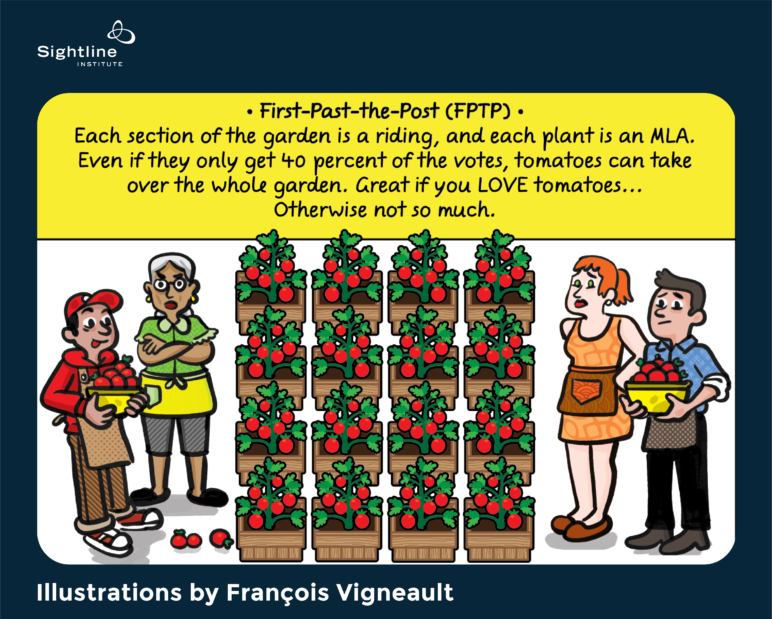
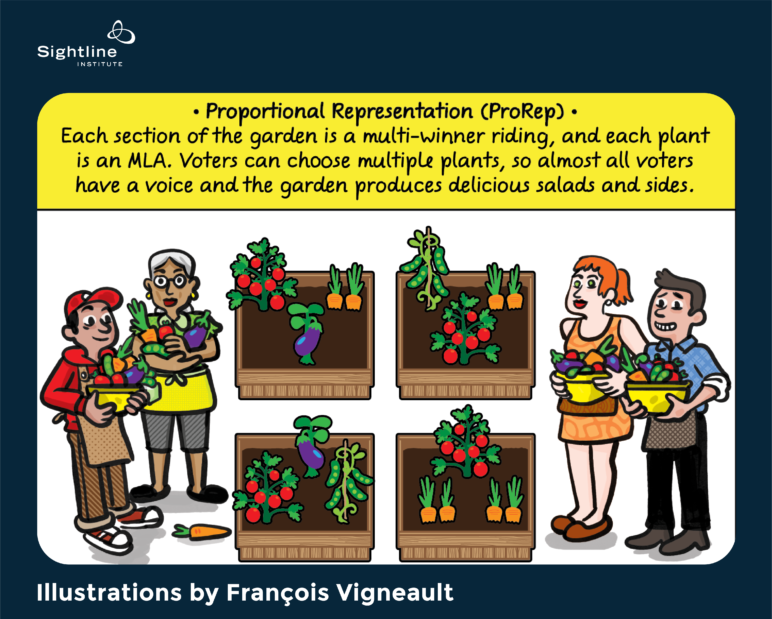
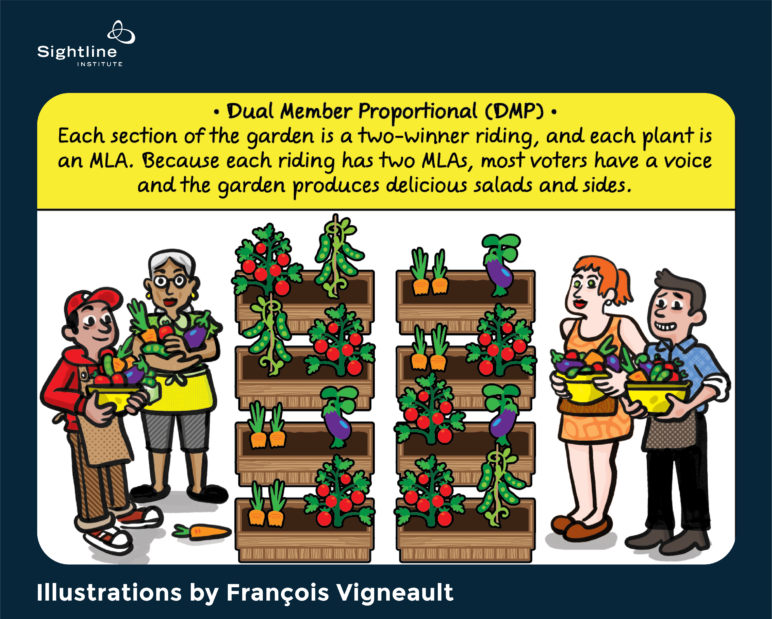
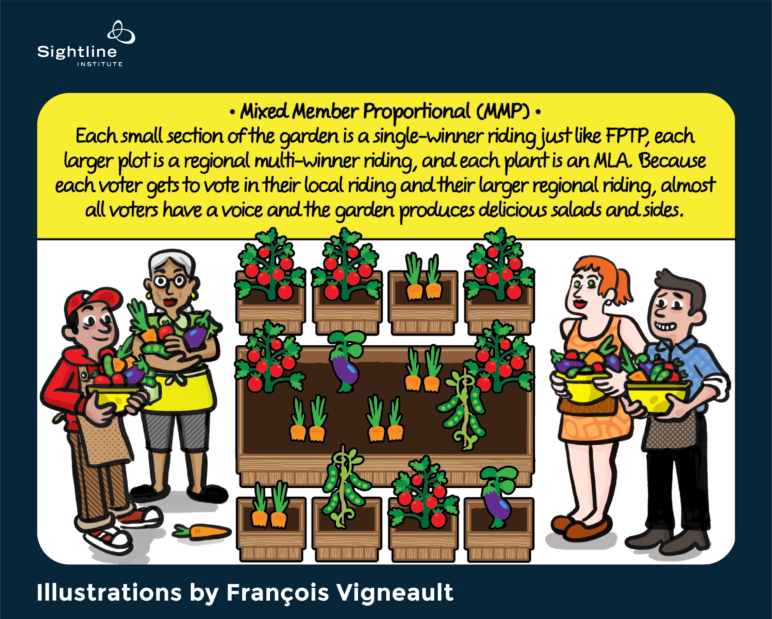
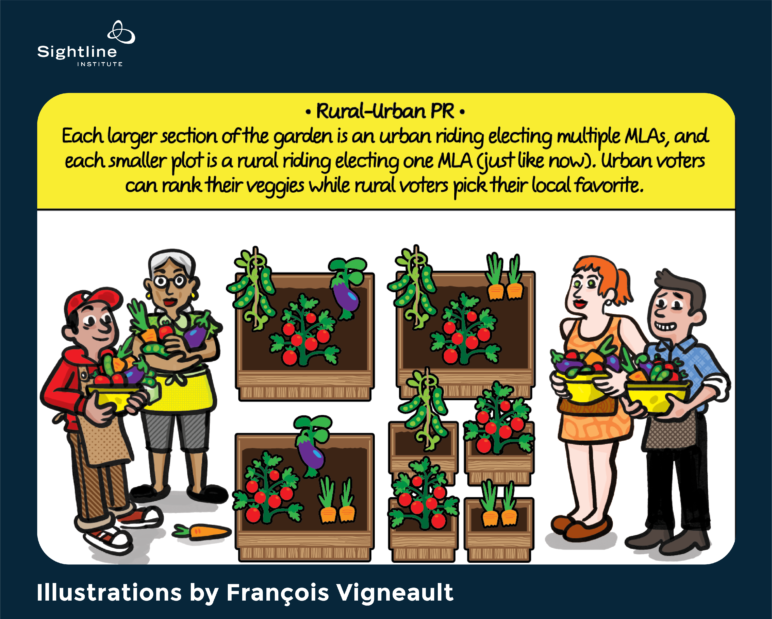






Karen Fink
Great article! Definition of “MLA” and “ridings” would help American readers.
Pat
MLA stands for Member of the Legislative Assembly -so the elected provincial politician. A riding is an electoral district or a constituency. Some Canadian provinces use different terms. For example, in Ontario the provincial politician is called an MPP which I think stands for Member of the Provincial Parliament.
Federally we use the term MP for Member of Parliament.
Hope this helps!
Bruce Lemire-Elmore
Hi, Christine — Superb job explaining Proportional Representation and the current campaign in BC! You chose a metaphor that appreciates variety and that is very helpful in leading into the democratic values of proportional representation in contrast to the power focus of first past the post.
– Bruce Lemire-Elmore, Victoria
Blaine Monson
Voting needs to be restricted to plus 65 white males.
ion delsol
Question to Kristin Eberhard on ProRep
If all three ProRep options follow a few ground rules: each would empower the will of the party, above that of voters elected, local representative, and…
If direct democracy by referendum on issues, gives voters the choice to grow tomatoes, or any kind of veggies without the authority of any party, and…
If electing representatives, MLAs, under FPTP or under any kind of ProRep, requires a majority of red MLA tomatoes, orange MLAs, or Green veggies to form government when the Oranges and the Green veggies have made a coalition to form government.
Why do we need smoke and mirrors about “electoral change” when what we need to change is the representative system, of any colour, with “participatory democracy” by referendum on issues like the Site C Dam?
Mike Mitchell
What if /my/ mla gets (say) 40% of the vote, but provincially his/her party gets less than 5% — does he/she lose the seat?
Sue Stroud
No your MLA would get their seat and be seated as an independent. Any of these 3 systems is vastly superior to what we have here in BC. A few days ago we re-instated the BC Human Right Commission. The NDP set up the commission in the 1990s then the BCLiberals got in and in 2002 abolished it, the NDP with the Greens have now re-established what is a democratic basic necessity, but if the no side wins the referendum we will have another FPTP election, the BCLibs may win and if so they will toss the commission again. This is harder to do under ProRep as you need the agreement of parties representing more than 50% of the population to change legislation (which we almost never have under FPTP where 30-40% of the vote can get you 100% of the power). Out too, would go the new legislation banning big money in politics and this one is why the BCLibs and their big money backers are fighting the referendum with every falsehood and scare tactic they can come up with. If you have friends, colleagues or family in BC ask them to vote yes for all our sakes. If we win in BC we can influence the continent to vote for PR. If they need help deciding send them this quiz referendumguide.ca Just in case any doubts the fairness of the campaign, the BC Supreme Court just ruled it is a fair process and is not designed to have any pre-determined outcome.
Christina Smith
Is the PR system going to put more people in government or redistribute current number of seats?